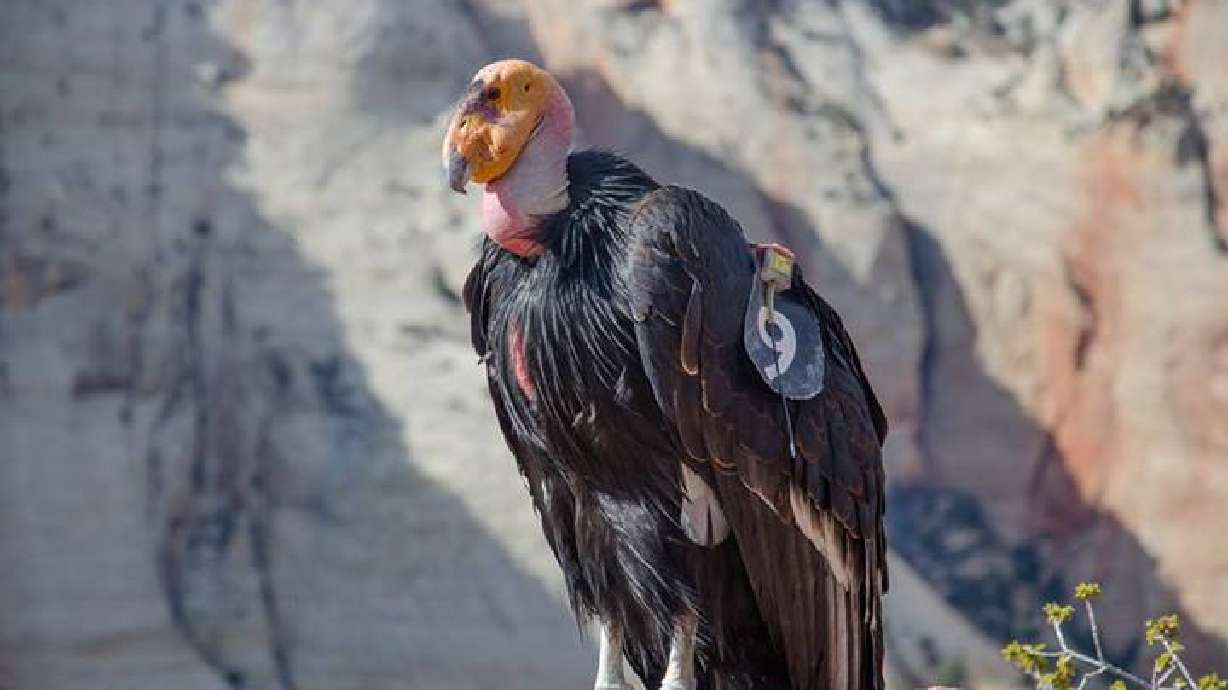Estimated read time: 4-5 minutes
This archived news story is available only for your personal, non-commercial use. Information in the story may be outdated or superseded by additional information. Reading or replaying the story in its archived form does not constitute a republication of the story.
SALT LAKE CITY — The avian influenza outbreak that has impacted millions of birds across the U.S. for over a year is now taking a toll on efforts to save a severely endangered species found in Utah and other parts of the Southwest.
The U.S. Fish and Wildlife Service officials said Wednesday that six free-flying California condors in the Arizona-Utah flock have died from the influenza outbreak, while 12 more have died from suspected influenza cases in the last few weeks. Another five birds are receiving "supportive care" as they are tested for the virus, according to the agency.
Utah wildlife officials confirmed to KSL.com on Thursday that none of the cases are on the Utah side of the flock range at the moment. The flock's range includes Zion National Park and other parts of southern Utah, as well as Grand Canyon National Park and northern Arizona. There were 116 condors in the flock based on a count conducted last year.
Joanna Gilkeson, a spokeswoman for the U.S. Fish and Wildlife Service, told KSL.com that it is "an evolving situation and moving quickly."
Efforts are underway to protect condors in Utah. The Peregrine Fund, a nonprofit that manages the Arizona-Utah flock, reports that it is working with Zion National Park officials on an "emergency effort" to rappel large cliffs in the park and recover the condors that nest there. Gilkeson said that only birds showing signs of illness will be removed from the wild, though.
The virus has also not been detected among the populations in California or Baja California, Mexico, according to federal officials. They say they will continue to monitor the birds to make sure they remain healthy out in the wild.
While there have been some human cases, the outbreak isn't considered a public health concern for humans. But it's a blow to efforts to save the species, which has been considered endangered since 1967.
"It's hard to speculate on what this means for the recovery of the population in the Southwest," Gilkeson said. "We're still gathering information and trying to assess the situation. We'll see how this unfolds but, prior to this outbreak of avian flu, lead poisoning has been the No. 1 threat to condors in the region."
Avian flu was first detected in California condors near Utah last month when biologists with the Peregrine Fund began noticing a bird showing signs of illness in Arizona. The team tracked the bird, a female condor, until it died, recovering its carcass from below her nest on March 20.
They first suspected it was suffering from lead poisoning but the U.S. Department of Agriculture's National Veterinary Service Laboratory found on March 30 that it died from a subtype of the highly pathogenic avian influenza virus that began sweeping through the country's bird population last year.
It's unclear how the first condor became infected but the virus can spread quickly in birds through contact with other birds and through several other means, including the ingestion of an infected animal, Gilkeson explained. Condors feed on the carcasses of dead animals, so that could be where the first case originated.
Biologists also began finding other condors in the flock exhibiting the same signs of illness, causing them to investigate further. The team is now tracking all of the condors in the flock and capturing any that show signs of illness so they can be treated, according to Gilkeson.
There were a little over 500 living California condors at the start of the year, including nearly 350 out in the wild at the start of the year, according to Ventana Wildlife Society. It's a species that's steadily recovered as a result of a captive breeding program that was launched to save the species after the wild population fell to just 22 by the 1980s.
The Condor Recovery Program celebrated its 1,000th California condor chick in 2019 with the hatching of a bird named 1K at Zion National Park. Most California condors have tags so biologists can track them. It's unknown if 1K or his parents, 409 and 523, are among the impacted condors because federal wildlife officials have not released the identification tags of the birds that have died or have fallen ill.
Gilkeson said the U.S. Fish and Wildlife Service will release the tag identification numbers at a later time.
"We know that there are certain birds that people follow and love, and have an affection for," she said.
The ongoing avian influenza outbreak was first detected at the beginning of 2022, spreading quickly across the U.S. More than 50 million wild and caged birds in the U.S. had died from the virus by November, the Associated Press reported. The outbreak is one of the key reasons prices for chicken, turkeys and eggs soared to record highs.
There have also been dozens of confirmed avian influenza cases among wild birds in Utah since April 2022, according to the Utah Division of Wildlife Resources. Geese account for nearly half of those cases, though it has also impacted ducks, gulls and a few other species, too.









